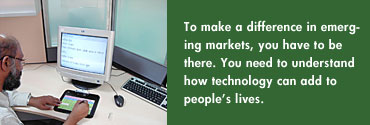
by Simon Firth
Western soft drinks or laundry soap can be sold in developing
nations with little more than a change in the packaging,
but when it comes to Information Technology, things get a
lot more complicated.
Consider the basic process of entering data into a computer.
The QWERTY keyboard and touch-typing, which most people in
the West take for granted, don't work in places like India
or China, where language isn't based on the Roman alphabet.
Computers themselves are problematic in a place where few
people can afford to purchase one.
But that doesnít mean advanced technology canít make a big
difference in people's lives. "It can," says HP Labs India
Director Ajay Gupta, "when the technology is designed with
their particular needs in mind."
To make a difference in emerging markets, "you have to be
there," he says. "You have to understand the context -- not
just affordability, but factors like differences in computing
interfaces, language and in the communications infrastructure
itself. You also need to deeply understand how information
technology can add to peopleís lives."
It was these insights that led to the launch of HPís India
Lab in February 2002. The lab was charged with surveying
the unique challenges and opportunities in emerging markets,
and developing appropriate products and services that have
the potential to lead to new HP businesses.
Two years on, the Bangalore-based lab has begun to see some
of the fruits of its research.
One early development addresses the problem of the traditional,
Western-style keyboard. "On the Indian subcontinent,
some 15 different scripts are used by about 1.5 billion people," Gupta
says. "But because these scripts are syllabic in nature,
using hundreds of syllables, you cannot have a keyboard with
one key per written symbol.”
In such languages, a small group of basic characters are
modified by strokes of a pen to create the many syllables
out of which words are built.
In response, researchers designed a hybrid keyboard that
uses both typing and pen strokes. With a pen, a user picks
out a basic character in a language such as Tamil or Hindi
on the keyboard of a position-sensitive tablet, and then
writes the appropriate modifier over the character using
the pen. This not only reflects the way in which syllables
are formed in such languages, but neatly supplants the convoluted
way in which they have to be created on a conventional QWERTY
keyboard.
By coupling an understanding of how people write in such
languages with expertise in handwriting recognition, says
Gupta, researchers at the India lab have been able to develop
such solutions rapidly. Less than six months after it was
conceived, a prototype keyboard was ready to demonstrate.
It has since attracted considerable interest from within
and outside HP and has the potential to bring computing to
a vast new population.
 |
|
Another device aims to provide the benefits of e-mail to
people who normally wouldn't use a western keyboard. This
simple, low-cost appliance lets users send handwritten e-mail
with a digital pen and a sort of souped-up clipboard. After
placing a paper form on the board to launch the application,
users can write on the form with the pen and see the content
of the message in a small LCD display at the top of the board.
Because the message is sent as a bit-map file, it can be
written by hand in any script. Once finished, the e-mail
is sent through any available network – LAN, wireline
or wireless phones.
Shekhar Borgaonkar, one of developers behind the concept,
believes it has tremendous potential. "Many Indian families
want to send e-mails today," he says, "but not
so often that they can justify owning a computer."
"The postman can carry this device from house to house," he
notes. Or, he says, such devices could be made available
on a pay-as-you-go basis in rural and urban phone kiosks.
A number of prototype devices are being deployed in a field
trial exploring usability and business models.
Although emerging markets face considerable challenges,
in at least one area they have an advantage over more developed
regions: a lack of legacy technologies. China and India are
the world's fastest-growing markets for mobile telephones,
including the newer CDMA and GSM technologies. Already in
India, there are more cellular phones than traditional wired
phones.
"While people may not have access to the Broadband
Internet, they do have access to cell phones," says
Gupta. "We believe that for a very large number of people,
the cell phone will be their computer."
As a result, the lab is exploring ways to use these robust
cellular networks to deliver IT in the form of voice-based
services, so that users with cell phones can get access to
banking services or purchase railway tickets. "Voice-based
information access is a real practical alternative for enterprises
to reach large numbers of customers in environments such
as India where Internet access is below one percent," says
K.S.R. Anjaneyulu, department manager, Language Technology
and Applications.
His team is working with such major universities as India's
IIIT Hyderbad and Carnegie-Mellon University in the U.S.
to create an ecosystem of researchers who are developing
open source systems for automatic speech recognition and
text-to-speech for the so-called "orphaned" languages – ones
that are spoken by millions of people but have not been addressed
so far.
Other key areas the lab is exploring include:
• An electronic form-filling tablet device able to
recognize multiple languages and translate each into a universal
data set.
• New pen-based input mechanisms that make IT more
accessible -- important because people in emerging markets
are familiar and comfortable with paper as a way to input
data.
• Making paper-based processes more efficient by adapting
the right balance between paper and electronic media.
• Technologies for effective mass communication using
rapidly changing television and radio broadcast networks.
Formal and informal education can be more efficiently delivered
to large and distributed populations using mixed-media broadcasts.
HP’s India Lab works closely with partner organizations,
including HP software development teams in the company's
Global Delivery India Center, as well as consulting firms
such as Human Factors International, which specializes in
user-related research. In addition, it has built strong university
relationships with key players such as the Indian Institute
of Technology in Madras, the Indian Institute of Science,
Bangalore, and National Institute of Design, Ahmedabad.
"The lab’s ability to connect with local HP country
operations in emerging economies and to enhance their capabilities
with new products and services is a key attribute, as is
its close connection with HP's vice president for strategy
for emerging countries," says Kris Halvorsen, director
of the HP Labs Solutions and Services Research Center and
an HP vice president.
"Our goal is to be close enough to the business teams
in these emerging geographies that they can confidently set
higher growth goals for their business because we are there
with them," he explains.
The success of the India lab has inspired HP to explore
additional development opportunities for emerging economies
around the world. Teams are putting together plans for China,
Russia and Brazil.
"The whole idea is to understand the context of each region
and integrate that in the technology solutions," says Gita
Gopal, program director, Research for Emerging Economies.
"
Whatís exciting now is the huge opportunity thatís ahead of
us,Ē she adds, "both in terms of the business engagements and
all the research threads we can explore. Itís probably more
than we have the time and resources to do, so we need to prioritize.
But thatís a good position to be in."
|

